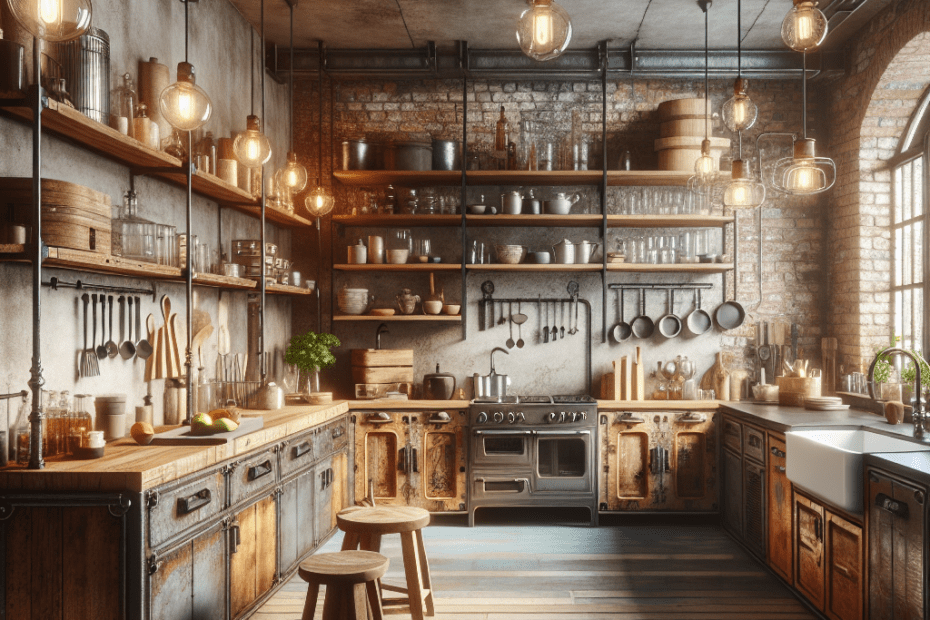“`html
Creating a Rustic Industrial Kitchen: Transform Your Space
The concept of a Rustic Industrial Kitchen combines raw elements and warm textures for those looking to have a unique and charming cooking space. This eclectic style captures the ruggedness of industrial design and the warmth of rustic appeal. People across different backgrounds are increasingly drawn to this design aesthetic as it offers both functionality and aesthetics.
The Essence of Rustic Industrial Kitchens
Rustic industrial kitchens, at their core, present a pairing of seemingly conflicting elements like metal and reclaimed wood, yet they meld seamlessly together. These kitchens prominently feature open shelving, exposed brick walls, and vintage lighting fixtures which not only serve a purpose but also create a space filled with character.
According to a survey by Houzz, 41% of homeowners opted to remodel their kitchens with industrial elements post-2020 (Houzz), which signifies rising popularity. This design is appealing, not just for its aesthetic allure, but for its practicability, particularly for open-plan living.
Design Elements
The charm of a rustic industrial kitchen lies in its ability to blend the old with the new. Here are some key elements:
- Exposed Structures: Leaving beams, pipes, and brickwork visible to incorporate rough and unrefined beauty.
- Reclaimed Wood: Using salvaged wood for cabinetry or flooring for that authentic rustic touch.
- Metal Accents: From stainless steel appliances to iron light fixtures, these metallic elements bring an industrial edge.
- Open Shelving: Opting for shelves instead of closed cabinetry to increase accessibility and visual space.
Having an understanding of these core elements allows for a more coherent execution of the rustic industrial theme. Mixing textures and materials brings depth and a lived-in feel to the kitchen.
Color Palette
A typical rustic industrial kitchen relies on a muted or earthy color palette to maintain its grounded vibe. Shades of gray, earthy tones, deep blues, and natural wood colors often serve as the canvas. The use of metals such as brass or copper adds a pop of contrast.
Lighting That Fits the Aesthetic
Lighting plays a crucial role in shaping the character of any kitchen, especially in achieving an industrial look. Pendant lights, particularly those with Edison bulbs, are iconic to the style. Additionally, vintage chandeliers or metallic finishes provide a warm ambiance.
According to Lighting Journal, retro lighting sales have increased by 30% from 2022 (source: Lighting Journal), underscoring the trend’s growing popularity.
Incorporating Personal Touches
Personalization is vital in making a space truly one’s own. For a rustic industrial kitchen, they might explore incorporating vintage decor like old clocks, antique pots, or even a chalkboard panel for notes and recipes. Small green plants or herbs can bring a touch of nature amidst the industrial tone, adding warmth and life.
Creating Contrast
Contrast plays a powerful role in creating visual interest. They could pair smooth, cool metals with soft, warm fabrics, like a metal bar stool with a cushioned seat. The use of tiles or backsplashes in designing also breaks the monotony while providing functional benefits.
In fact, an industry report from Statista notes a 15% annual increase in tile usage in kitchen renovations since 2021, demonstrating its popularity for its contrasting and practical benefits (Statista).
| Design Element | Description |
|---|---|
| Exposed Structures | Showcases raw architectural elements like beams and brick. |
| Reclaimed Wood | Utilizes salvaged wood for a rustic charm. |
| Metal Accents | Incorporates metallic elements for an industrial edge. |
| Open Shelving | Provides accessibility and enhances visual space. |
Key Takeaways
- A rustic industrial kitchen brings together raw and warm elements to create a balanced design.
- Essential features include exposed structures, reclaimed wood, metal accents, and open shelving.
- A muted and earthy color palette supports the overall aesthetic.
- Lighting, especially vintage or pendant styles, significantly influences the space’s ambiance.
- Personal touches like vintage decor and contrasting materials enhance the space.
FAQ
-
What is a rustic industrial kitchen?
It is a kitchen that combines the raw, structural elements of industrial design with the warmth and textured surfaces of rustic design.
-
What are key materials used in this style?
Common materials include reclaimed wood, metal (like iron or steel), and exposed architectural elements such as brick and beams.
-
Who should consider a rustic industrial kitchen?
Anyone looking for a unique kitchen style that offers both visual appeal and functional efficiency, especially in open-plan spaces.
-
How can they personalize this kitchen style?
They can add vintage items, use a mix of textures, and add personal touches like a chalkboard wall or indoor plants.
-
What color schemes work best?
Muted or earthy tones, complemented by metallic finishes, are ideal for maintaining the rustic industrial aesthetic.
“`
